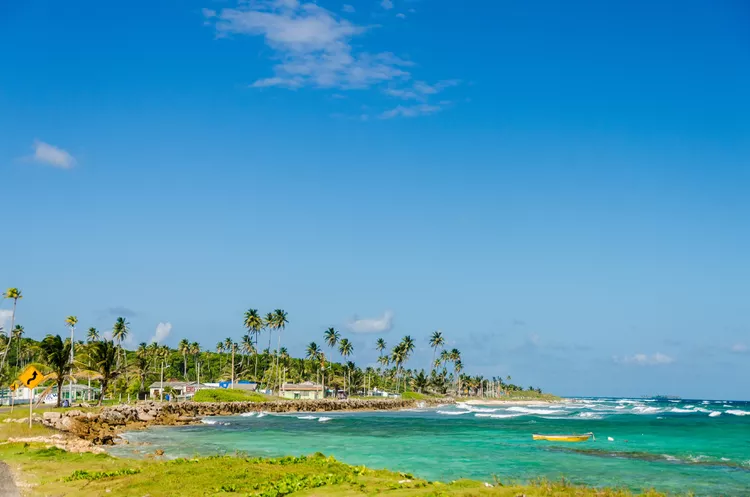San Andrés: A Caribbean Paradise
Visitors seeking extraordinary diving experiences amidst crystal-clear waters, warm white sandy beaches, vibrant nightlife, and colorful culture flock to San Andrés in the Caribbean. Moreover, it offers a diverse array of full-amenity accommodations, relaxation options, and duty-free shopping.
With a rich and multi-ethnic history, San Andrés presents a unique cultural experience, from the local cuisine to the native languages spoken. While Spanish is the official language, English is also prevalent, accompanied by the sounds of salsa and reggae.
Location
The San Andrés, Providencia y Santa Catalina archipelago, recognized by UNESCO as a World Biosphere Reserve, lies 480 miles (720 km) northwest from the Colombian Caribbean coast. The archipelago includes the islands of San Andrés, Providencia, and Santa Catalina, as well as Bolivar and Albuquerque islets, Cotton, Haynes, Johnny, Serrana, Serranilla, Quitasueno, Rocky, Crab cays, and Alicia and Bajo Nuevo sandbanks.
Familiarize yourself with this map from Expedia.
Getting There
San Andrés is strategically located on the Central American-Colombian route. Access the island via air by charter flights or international routes to Gustavo Rojas Pinilla Airport on San Andrés. Airlines such as Avianca, Satena, and Aerorepublica operate flights from various Colombian cities. Additionally, you may find other flight options from your location.
Travelers can also reach San Andrés by sea from any port in the Caribbean; however, there are no ferries to the other islands or the mainland, and the cargo ships do not transport passengers.
Stay updated with the current weather and forecasts. The islands’ climate averages 70 to 80+ °F year-round, featuring winds between 5 mph to 15 mph. The dry season lasts from January to May, with a secondary, less dry season occurring in August and September.
Recognized as a duty-free port, San Andrés invites visitors into its luxuriant green landscapes, secluded cays, and almost private beaches. Furthermore, many attractions stem from the islands’ natural beauty and rich history.
Background
Situated closer to Nicaragua and Jamaica, the Colombian territory of the archipelago emerged through a tumultuous history of piracy, warfare, slavery, immigration, agriculture, and cultural transformations.
Initially settled by the Spanish in 1510, the islands were part of the Audiencia of Panama before transitioning to the Capitanía of Guatemala and Nicaragua. Their strategic location drew the attention of Dutch and English privateers; legend has it that Henry Morgan’s treasure is hidden in one of San Andrés’ caves.
Subsequent migration from English Puritans and Jamaican woodcutters marked the islands’ evolution until 1821 when Francisco de Paula Santander integrated them into Colombia, officially raising the Colombian flag on June 23, 1822.
The economy originally relied on sugar and cotton plantations, drawing in enslaved individuals from Jamaica for labor. Despite becoming part of Colombia, English influences persisted in its architecture, language, and religious practices.
The archipelago consists predominantly of two main islands: San Andrés and Providencia. San Andrés, at the southern tip, stretches 13 km long and 3 km wide, characterized by its flat terrain with El Cliff marking the highest point. This area also serves as the hub for tourism and commercial activities.
While the island permits walking, scooter or moped rentals facilitate exploration for adventurous visitors.
Providencia, located approximately 90 km north of San Andrés, is a smaller and quieter island, historically less influenced by tourism. Nevertheless, it is fast becoming a fashionable destination. It attracts snorkelers and divers seeking the clarity of its coral reefs. The island’s interior comprises lush tropical vegetation, and a hike from Casabaja to El Pico offers stunning panoramic views.
Lodgings and Dining
San Andrés features numerous hotels in El Centro and Decameron resorts cater to various tastes and budgets. The culinary scene predominantly showcases island cuisine, which highlights fresh fish and local vegetables using ingredients such as coconut, plantain, and spices. A must-try dish is rondón, a delicious concoction of fish, pork, conch, plantain, and coconut milk, available in restaurants or roadside stands.
Things to Do and See
- Engage in duty-free shopping for local products, including Colombian emeralds.
- Hike from El Centro to El Cliff for breathtaking views of the town and surrounding coral reefs.
- Partake in activities like swimming, horseback riding, parasailing, and windsurfing, or simply relax on the beach:
- Sprat Bight, the most popular beach in San Andrés, offers spectacular shallow waters ideal for swimming. Small boat rentals are available for fishing or exploring nearby cays.
- Sound Bay, located in San Luis, is renowned for the crashing waves against the coral.
- Cocoplum Bay features a gentle beach slope and shallow waters, perfect for swimming.
- The Cove is accessible to divers who can step directly into the water to reach the coral reef.
- Dive and snorkel at several premier locations characterized by calm waters, moderate temperatures, and exceptional visibility.
- Visit Johnny Cay, also known as Islote Sucre, a small neighboring island with pristine sandy beaches, clear waters, and lush tropical vegetation.
- At the southern end of San Andrés, discover El Hoyo Soplador, a natural seawater geyser visible only in specific conditions.
- Explore La Cueva De Morgan or Morgan’s Cave, a fascinating sea cave constantly reshaped by water action and rich in treasure hunting lore.
- Experience La Loma, a small hamlet where traditional island life persists and visit the Iglesia Bautista Emmanuel, the first church established on the island, which serves as a maritime landmark.





